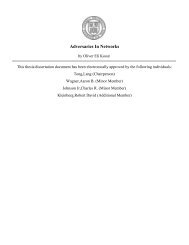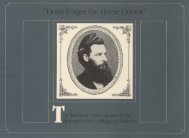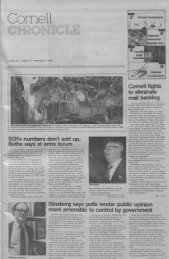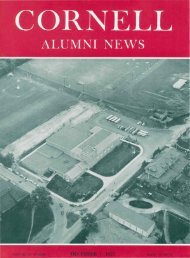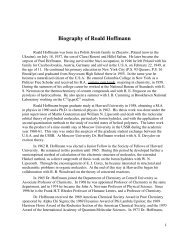Preliminary pages FINAL.pdf - eCommons@Cornell - Cornell ...
Preliminary pages FINAL.pdf - eCommons@Cornell - Cornell ...
Preliminary pages FINAL.pdf - eCommons@Cornell - Cornell ...
You also want an ePaper? Increase the reach of your titles
YUMPU automatically turns print PDFs into web optimized ePapers that Google loves.
Daniel Leech-Wilkinson has begun to address these questions from the point of<br />
view of the listener. In his forthcoming book, The Changing Sound of Music:<br />
Approaches to Studying Recorded Musical Performances, Leech-Wilkinson notes the<br />
usefulness of metaphorical language and incorporates it into analytically rigorous<br />
methodologies. His groundbreaking work includes combining subjective descriptions<br />
of recordings with spectrographic measurements that provide visual evidence of vocal<br />
effects. He also draws on the work of cognitive psychology to explore why listeners<br />
are moved by certain sounds. In these ways, Leech-Wilkinson’s work aims to<br />
describe how performance is experienced by the listener.<br />
It is also possible, however, to describe the sounds singers make from the point<br />
of view of the performer. Many of the gestures commonly considered under the<br />
heading of style are in fact grounded in a singer’s technique. Vibrato, tempo and<br />
rubato are directly affected by certain corporeal realities, such as a singer’s voice type<br />
and his physical condition, and portamento has long been a technical term as well as a<br />
stylistic one. If we consider these technical underpinnings of style, we are inevitably<br />
moved to ask the question: when is style art and when is it function? To put it another<br />
way: how do the habitual choices singers make in the practice room affect their<br />
stylistic choices, or whether they are even able to make certain style choices at all?<br />
How do the physical realities of aging, gender and voice type impact a singer’s style?<br />
These are the questions that give rise to this dissertation, which discusses style as a<br />
function of the physical act of singing.<br />
Because academic study of recordings is in its infancy, we must start with<br />
some basics. There are numerous challenges associated with using recordings,<br />
especially early ones, as sources. Moreover, choosing a particular repertoire – in this<br />
case, Lieder – influences not only the kinds of questions that can be asked about style,<br />
xxiv




